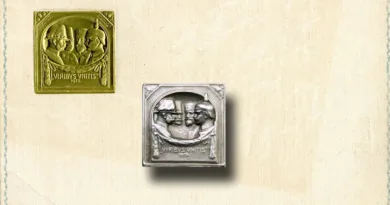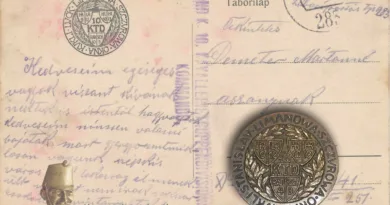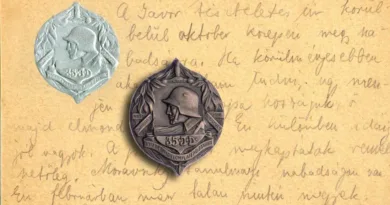Airmail Fortress Przemysl – 1. Army
The main curiosity of this post, of course, is not so much the badge of the 1st Army, which was one of the first cap badges by the way. Rather, the stamp on the card that reads: “KuK Airmail Przemysl Fortress 1914-1915”. According to an interesting study, this stamp was probably printed on field post cards in early 1915, during the siege. Apparently the stamped post card was then not sent because there was no addressing on it.
The enclosed Przemysl could be reached at the cost of hardship, as Russian besiegers kept firing on planes and balloons appearing in the area. With the contemporary means any significant amount of munitions and food naturally could not be transported by air. Therefore, air traffic primarily facilitated the flow of military information and targeted mail traffic that improved the morale of the enclosed 120,000 crew. It can be stated with certainty that aircraft flew in and out of the fort at least ten times between 18 January and 22 March 1915. The flights took place between the fortress and the nearby Austro-Hungarian cities (eg. Jaslo).
For this purpose, the fortress headquarters produced postcards of much thinner material than usual, which the members of the guard could send home. It is believed that there was also inbound mail traffic. To send a larger mass of letters, balloon post was also sent out of the castle. The letters in the baskets of helium-filled balloons flew over the besieging Russians in favorable winds and landed possibly in a place where locals noticed the shipments.

Airplane and balloon postcards alike are extremely rare, valuable collections among philately enthusiasts. Contrary to the aforementioned publication, the field postcard attached to the post was not stamped at the time of the siege, but afterwards. The greater material thickness of the card and the absence of the addressee, as well as the postage stamp used in civil circulation, also indicate this. It is possible that after the liberation of Przemysl, such a commemorative stamp was used in the city from mid-1915. The cap badge on the card is the first badge of the 1st Army, which was certainly made in late 1914, and the postcard decorated with it may be early, but I also don’t think it was before June 1915. But who knows?




